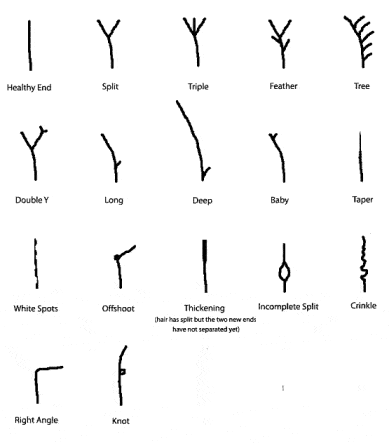Updated: March 10, 2021

If your natural hair has been the same length for years, or it doesn’t seem to grow, then you probably have a problem retaining length. The primary reason people can’t retain length in their natural hair is that they experience excess split ends.
When this happens, it means that the ends of your hair are literally splitting faster than the hair is growing out of your scalp. As a result, you’re cutting your ends off at the same rate it is growing.
Basically, your hair stays exactly the same length for this period of time!
In this article, we’re going to be talking about what exactly split ends are, why they happen, and how to prevent them along your natural hair journey.
What is a Split End and How Does a Split End Form?
Split ends simply refer to the ends of your hair becoming split, or frayed as a result of dryness, being brittle, or just worn from normal wear and tear.
This damage or splitting can also be caused by harsh techniques such as heat styling (blow drying or straightening), as well as high manipulation, or even the products you use!
Split ends are a normal part of any hair journey, you just have to be conscious about the number of split ends you’re getting in your hair.
Are there Different Kinds of Split Ends?

There are 5 major kinds of split ends. They include:
- Basic Splits: This is early-stage hair damage.
- Taper/Candle Splits: This happens when you completely lose the outer cuticle of your hair. The strand is already damaged, even though it hasn’t started splitting yet.
- Baby/Mini Splits: This is the beginning of a basic split.
- Tree Splits: This is an advanced or late-stage split, and shows signs of extreme damage to the hair cuticle.
- The Single Strand/Fairy Knot: We curly girls know this one well. This usually happens when a curly strand of hair gets so tangled on itself that it forms an inseparable knot.
There are a bunch of other splits which include Crinkle, Triple, Feather, Double Y, Long, Deep, Thickening, Right Angle, White Spots, Offshoot, and Incomplete.
The precise kind of split doesn’t actually matter so much. However, its more important to know how advanced the damage is. And if the cuticle of the hair is being worn off without splitting, it may be caused by chemical rather than physical damage.
How to Get Rid of Split Ends on Natural Hair
Identifying the kind of split you have may give you insight into what caused the split end. This insight may help you prevent split ends in the future.
However, once you do get a split end, the only way to get rid of it is to cut it!
So all those products marketed to “cure” or “heal” split ends are just that. Marketing. There is no way to heal a split end or seal your ends back together permanently.
How to Prevent Split Ends in Natural Hair
1. Trim your hair with sharp shears ONLY.
Trimming with dull shears further damages the hair cuticle, causing it to more prone to splitting. We have a whole article about different techniques to trim the split ends in your hair.
2. Reduce the amount of manipulation you put your hair through.
i.e. stop touching your hair so much!
3. Trim a split end as soon as you see it,
and before it gets too advanced. This is called dusting.
4. Moisturize your hair!
Dry hair is most prone to splitting and fraying at the ends. Keep your hair moisturized by using any (or all) of these 8 methods and never skipping deep conditioner.
5. Keep your ends tucked away.
Wear protective styles like buns and other low manipulation styles that keep the ends of your hair away from anything that can damage them.
6. Detangle your hair carefully.
The most common way we ladies with natural hair get split ends (especially single strand knots) is by detangling roughly.
You should detangle gently, finger detangling first, then optionally again using a brush that’s adapted to curly hair. Here are Hibiscus Roots, we like this Tangle Teezeer or the Felicia Leatherwood brush.
7. Reduce heat styling.
If you’re ever experiencing any kind of damage to your natural hair — and especially excess splitting — reduce the amount of heat you use in your hair.
Heat is especially drying to natural hair. The process itself also involves a lot of detangling, brushing, and combing (manipulation) to be successful. All of which contribute to split ends and eventual breakage.
We love the reviews and the demos on the Revair Reverse Air Dryer when it comes to reducing damage to the hair cuticle during the blow drying process. If you have one or you’ve ever used one in the past, please let us know what your experience was in the comments!


